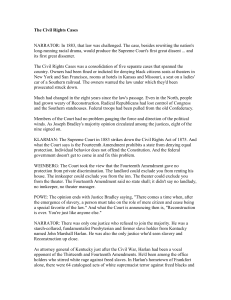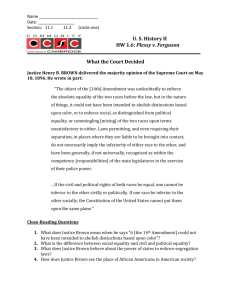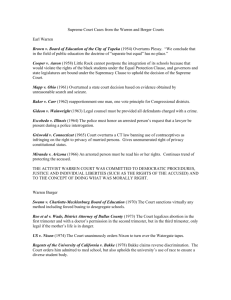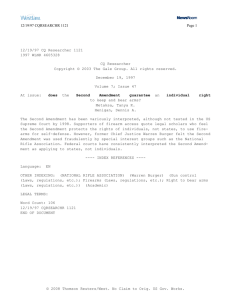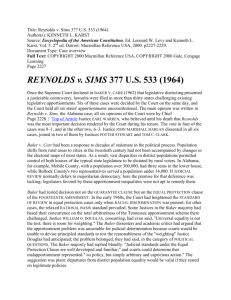Constitutional Reapportionment
advertisement
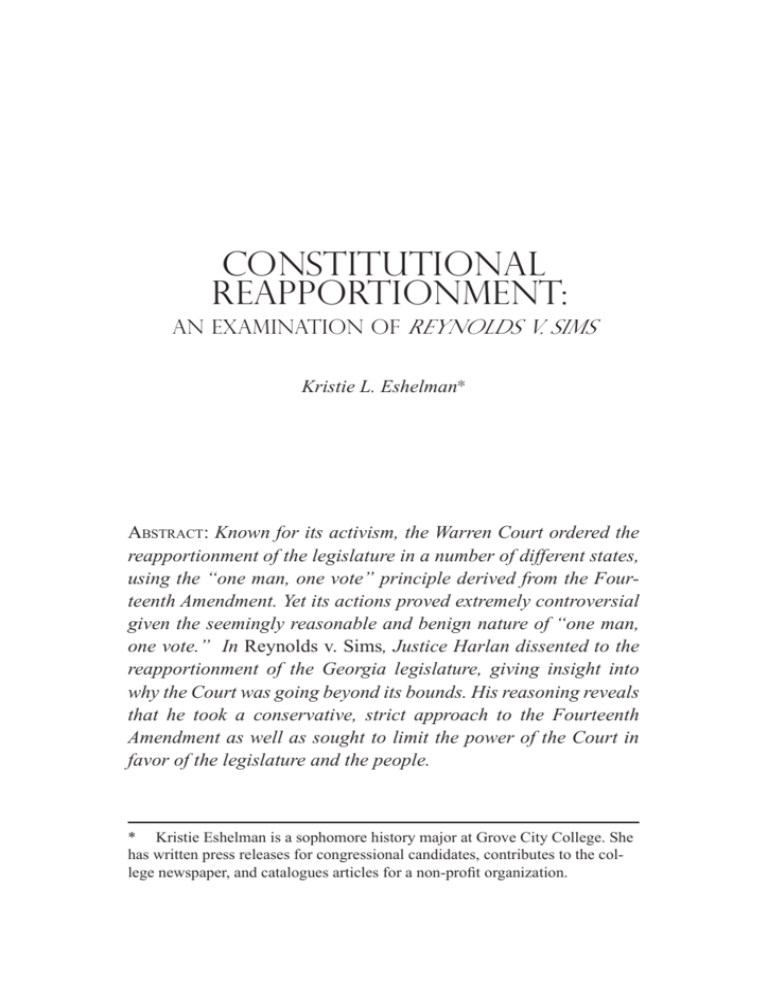
Constitutional Reapportionment: an examination of Reynolds v. sims Kristie L. Eshelman* 1 Abstract: Known for its activism, the Warren Court ordered the reapportionment of the legislature in a number of different states, using the “one man, one vote” principle derived from the Fourteenth Amendment. Yet its actions proved extremely controversial given the seemingly reasonable and benign nature of “one man, one vote.” In Reynolds v. Sims, Justice Harlan dissented to the reapportionment of the Georgia legislature, giving insight into why the Court was going beyond its bounds. His reasoning reveals that he took a conservative, strict approach to the Fourteenth Amendment as well as sought to limit the power of the Court in favor of the legislature and the people. * Kristie Eshelman is a sophomore history major at Grove City College. She has written press releases for congressional candidates, contributes to the college newspaper, and catalogues articles for a non-profit organization. 32 Grove City College journal of Law & Public Policy [Vol 2:1 Hailed as a champion of democracy and equal rights, the Warren Court faced some of its most difficult and important decisions with the reapportionment cases of the 1960s. In particular, Baker v. Carr, 369 U.S. 186 (1962) and Reynolds v. Sims, 377 U.S. 533 (1964) proved extremely significant to the overall controversy. Not only did these decisions result in the reapportionment of the legislature in many states, they also expanded the power of the federal government and the judiciary, setting precedent in constitutional interpretation. As the Court adopted a broad interpretation of the Constitution to determine these cases, only Justice John Marshall Harlan dissented in every reapportionment case. In fact, he stood as the lone dissenter in Reynolds v. Sims, a case that required both houses of the Alabama legislature to reapportion their voting districts based entirely on population. Justice Harlan’s eloquent, well-reasoned argument proved momentous to the study of law and the Constitution. Justice Harlan objected to the Court’s interference in legislative affairs and criticized decisions which lacked judicial standards, reliance on precedent, or narrow interpretation of the Fourteenth Amendment. In doing so, Justice Harlan sought to preserve the Court’s traditional functions. Appointed to the Supreme Court by President Eisenhower in 1955, Justice Harlan immediately aligned himself with Justice Felix Frankfurter, an outspoken advocate of judicial restraint.1 Indeed, Justice Harlan became known as the “great dissenter” of the Warren Court because of his opposition to the broad interpre1 John P. Frank, The Warren Court 111 (1964). 2011] Constitutional reapportionment 33 tation of the Constitution which allowed the Court to play a larger part in controversial policy disputes. Chief Justice Earl Warren’s willingness to extend the Court’s historical role irritated Justice Harlan, who had “clear notions of what the law ought to be but [he did] not regard himself as employed by the people of the United States for the purpose of making it.”2 Along with Justice Frankfurter, Justice Harlan adhered to the “Weschslerian ideal,” which is the principle that the Court should only decide cases based on objective and neutral standards rather than on mere social utility developed by Herbert Wechsler, a Columbia University law professor.3 Justice Harlan believed that even honest attempts to achieve justice without adherence to the principles set forth by precedent and the Constitution could result in judicial miscalculation and favoritism. Baker v. Carr provided the precedent necessary to pave the way for the Warren Court’s decision in Reynolds v. Sims. In fact, the situation in Baker was almost identical to that of Reynolds: In 1901, the Tennessee General Assembly enacted legislation which reapportioned the state’s legislative districts according to population and promised reapportionment every ten years. Unfortunately, this reapportionment policy was never actually enforced, and by the 1960s “counties containing more than 60 percent of the population elected about a third of each house,” a 2 Id. at106. 3 Herbert Wechsler, Toward Neutral Principles of Constitutional Law, 73 Harv. L. Rev. 1, 5 (1959). 34 Grove City College journal of Law & Public Policy [Vol 2:1 situation which led to a “loss of confidence in local government, coupled with an ever growing tendency to bypass state capitals in favor of national solutions.”4 In such a case, the votes of those in districts with a higher population – usually urban districts – carried less weight than the ballots of those in areas with a lower population. Incensed by the seeming injustice of the status quo, Charles Baker, a resident of an urban district in Tennessee, sued Tennessee Secretary of State Joe Carr, demanding reapportionment by population. Baker claimed that the state was depriving him of equal protection of the law promised by the Guarantee Clause of the Fourteenth Amendment. The U.S. District Court for the Middle District of Tennessee dismissed the suit, holding that the issue was political and not judicial and so Congress, rather than the judiciary, should settle that problem. On direct appeal, the Supreme Court held that Baker’s complaint was justifiable and formulated the “one man, one vote” standard. Robert Dixon, a professor of law at George Washington University who has studied the apportionment cases extensively, writes that many believed only judicial action could bring true reform: “As was noted at the time, political avenues for change had become dead-end streets; some judicial intervention in the politics of the people seemed necessary to have an effective political system.”5 Justices Frankfurter and Harlan, however, disagreed 4 Archibald Cox, The Warren Court 115 (1968). 5 Robert G. Dixon, The Warren Court Crusade for the Holy Grail of One Man, One Vote, Sup. Ct. Rev. 219, 224, (1968) [hereinafter The Warren Court Crusade]. 2011] Constitutional reapportionment 35 with the majority, claiming that the Court would be encroaching on legislative affairs if it entangled itself in a political question, and that no definable standards existed by which the Court could make its judgment. The Justices had precedent on their sides. Historically, the Court refused to judge cases involving other branches of government unless they involved clear, objective constitutional principles.6 Abstaining from involvement in political questions legiti- mized the Court in the eyes of the public. In his dissent, Justice Frankfurter explained that “the Court’s authority—possessed of neither the purse nor the sword—ultimately rests on sustained public confidence in its moral sanction. Such feeling must be nourished by the Court’s complete detachment…from political entanglements and by abstention from injecting itself into the class of political forces in political settlements.”7 If the Court rejected its objectivity and respectability in order to involve itself in subjective political questions, it could lose its means of enforcement, the respect of the populace and the legislative branch, altogether.8 Clearly, Baker v. Carr raised controversy over the role of the Court and broke precedent concerning political questions, clearing the path for the Reynolds v. Sims decision. 6 Stanley H. Friedelbaum, Baker v. Carr: The New Doctrine of Judicial Intervention and its Implications for American Federalism, 29 U. Chi. L. Rev. 677, 683 (1962). 7 Cox, supra note 3 at 117. 8 Robert G. Dixon, Legislative Apportionment and the Federal Constitution, 27 Law & Comtemp. Probs. 329, 334 (1969) [hereinafter Legislative Apportionment]. 36 Grove City College journal of Law & Public Policy [Vol 2:1 Alabama faced apportionment problems similar to those of Tennessee, spurring M.O. Sims, along with several other Alabama voters, to sue the state in 1961. Alabama’s constitution promised reapportionment every ten years, allotting at least one legislator per legislative district and one senator per senatorial district, but, just like Tennessee, this had not been enforced. A federal district court ruled in favor of the disgruntled residents and, as a result, the Alabama legislature proceeded to form two reapportionment plans. As an amendment to the state constitution, the 67-Sena- tor Amendment sought to assign one senator to each of the state’s sixty-seven counties. Similarly, each county would receive one of the state’s 106 legislators while the rest would be apportioned by population. If the 67-Senator Amendment failed, the CrawfordWebb Act was to take effect in 1966, having already been signed into law by the governor of Alabama.9 Under this law, each of the thirty-five senatorial districts would receive one senator as well as a legislative apportionment scheme identical to that of the 67-Senator Amendment. However, the district court ruled both plans unconstitutional and the case soon appeared in the Supreme Court after a direct appeal by Reynolds. Chief Justice Earl Warren delivered the opinion of the Court, which ruled in favor of the voters as well. This time, only Justice Harlan dissented. The Court held that neither the Crawford-Webb Act nor the 67-Senator Amendment adhered to the Constitution because 9 Reynolds v. Sims, No. 23, 1964 U.S. LEXIS 1002, at *552. 2011] Constitutional reapportionment 37 they were not based strictly on population. Observing that these plans followed the pattern set out by the federal government – with legislators elected by population and senators elected by geographical region – the Supreme and district courts contested that the Alabama legislature had to base its plan entirely on population because “counties are merely involuntary political units of the State created by statute to aid in the administration of state government.”10 Thus, the Court reasoned that state and federal apportionment bore no similarity to each other. Furthermore, the Warren Court established the “one man, one vote” standard based on the principle that equal representation produced a democratic government. In one of his most famous statements, Chief Justice Warren argued: Legislators represent people, not trees or acres. Legislators are elected by voters, not farms or cities or economic interests. As long as ours is a representative form of government elected directly by and directly representative of the people, the right to elect legislators in a free and unimpaired fashion is a bedrock of our political system.11 Warren emphasized that weighing votes differently based upon where a person resided constituted discrimination comparable to that of discounting the votes of minorities or women. To justify his lack of historical precedent, the Chief Justice pointed to the 10 11 Id. at *548. Id. at *562. 38 Grove City College journal of Law & Public Policy [Vol 2:1 decision in Wesberry v. Sanders, 376 U.S. 1 (1964), wherein he had asserted that the principle of “one man, one vote” was derived from the Declaration of Independence, the Gettysburg Address, and the Fifteenth, Seventeenth, and Nineteenth Amendments to the Constitution.12 The single most important justification of the Court’s insistence on apportionment by population alone lay in the Equal Protection Clause of the Fourteenth Amendment which reads: No State shall make or enforce any law which shall abridge the privileges or immunities of citizens of the United States; nor shall any State deprive any person of life, liberty, or property, without due process of law; nor deny to any person within its jurisdiction the equal protection of the laws.13 The Court held that because the Equal Protection Clause required that all citizens receive equal treatment under the law, it must follow that attributing different weight to votes on the basis of geography violated constitutional principle. Mal-apportionment seemed unlawful because it undermined the right of equal protection to every citizen just as discriminating against a voter on the basis of his race or gender provided grounds for federal intervention.14 Warren continued his defense of the Court’s interven12 13 14 The Warren Court Crusade, supra note 4, at 221. U.S. Const. amend. XIV, § 1. Reynolds, 1964 U.S. LEXIS 1002, at *556. 2011] Constitutional reapportionment 39 tion by noting the words of the Guarantee Clause in Article Four, Section Four: “The United States shall guarantee to every State in this Union a Republican Form of Government.”15 Thus, Warren reasoned, the Federal Government and the Supreme Court had a right and a duty to ensure that every state apportioned its districts so that each vote had the same weight. Though a connection between the “one man, one vote” principle and a “Republican Form of Government” failed to appear anywhere in the Constitution explicitly, the Court inferred that it required equal weight for votes because the principle seemed so logical. Only Justice John Harlan stood against the rest of the Court. Along with many scholars and social scientists, Justice Harlan had practical reasons for disagreeing with the Court. Justice Harlan argued that pure per-capita representation oversimplified local politics, pointing out that this scheme always allowed the majority to smother the voice and representation of smaller groups.16 Alexander Bickel, a respected constitutional scholar states: 15 U.S. Const. art. IV, § 4. 16 Robert G. Dixon, Reapportionment and the Supreme Court in Congress: Constitutional Struggle for Fair Representation, 63 Mich. L. Rev. 209, 220, (1963) [hereinafter Reapportionment and the Supreme Court]. 40 Grove City College journal of Law & Public Policy [Vol 2:1 Government by consent requires that no segment of society should feel alienated from the institutions that govern. This means that the institutions must not merely represent a numerical majority…but must reflect the people in all their diversity, so that all the people may feel that their particular interests and even prejudices, that all their diverse characteristics were brought to bear on the decision-making process.17 Justice Harlan also worried that the majority’s ruling would permit gerrymandering, the act of adjusting political boundaries to affect the outcome of elections, and spent a great deal of his dissenting opinion on this topic. As Justice White observed, apportionment based solely on population could prove arbitrary: “If country and municipal boundaries are to be ignored, a computer can produce countless plans for absolute population equality, each differing very little from another, but each having its own very different political ramifications.”18 In fact, Congress in the late nineteenth century had decreed that national legislative reapportionment occur every ten years based on population, but the political consequences had proven so significant that it returned this power to the individual states.19 Finally, Justice Harlan observed that by the Court’s standards, most states in the Union would have to reapportion their districts because they had a geographically-based 17 Alexander Bickel, Politics and the Warren Court 184 (1965). 18 The Warren Court Crusade, supra note 4, at 221. 19 Michael R. Belknap, The Supreme Court Under Earl Warren: 19531969 110 (2005). 2011] Constitutional reapportionment 41 Senate and a population-based House of Representatives. Justice Harlan opened his dissent by noting the case’s lack of objective standards by which the Court could make its decision, reviving the political question that was so prominent in Baker v. Carr. He claimed that that the issues of the case rested on subjective whims and the self-interest of the parties involved rather than any law or constitutional principle. Urban residents, of course, desired reapportionment while residents of sparsely populated areas—such as farmers—preferred the status quo. No single standard existed that could mediate the desires of the parties in an impartial manner.20 In such matters, Justice Harlan argued, the Court would be meddling with another branch of government based on a political opinion. Like Justice Harlan, Bickel noted that “the political arena is messier than the judicial, to be sure, but that is where all of us who feel under- or misrepresented should be exerting every ounce of power and influence.”21 Thus, the reapportionment issue warranted action from the state legislatures, a group that citizens could lobby and attempt to sway, rather than from the supposedly impartial judiciary. Justice Harlan pointed to precedents which the United States had observed since the ratification of the Fourteenth Amendment. Citing the legislative history of the Fourteenth Amendment, Justice Harlan reasoned that since no judge had used the amendment to reapportion state districts, it was possible the original pro20 21 Craig L. Ducat, Constitutional Interpretation 60 (9th ed. 2009). Bickel, supra note 13, at 189. 42 Grove City College journal of Law & Public Policy [Vol 2:1 ponents of the Fourteenth Amendment never meant for the Court to do so.22 That precedent, he cited, allowed for “the proposition that in a democratic system a ‘population base’ must be a dominant feature in apportionment-districting…but some sense of ‘community’ is relevant too. A maximum allowable deviation of 10 or 15 percent…would terminate egregious population disparities while leaving room for accommodation of such ‘communities.’”23 Based on these facts, he observed that the bicameral congresses historically allowed for representation both by geography and population, thereby presenting an excellent compromise. Justice Harlan based his overall argument on a strict inter- pretation of the Constitution. The interpretive method in which many justices on the Warren Court indulged bothered Justice Harlan, who cared only about the facts of the case and how they related to the words of the Constitution. He concluded that since the Fourteenth Amendment failed to address the issue of reapportionment, “it did not demand rigid equality; it required only that any asymmetry be rational. The…decision to retain an old allocation of Legislative seats in order to maintain governmental stability and promote geographic and demographic balance was within the area the Fourteenth Amendment left to its judgment.”24 Unlike Justices Brennan and Warren, who clearly held to an agenda of egalitarianism, Justice Harlan attempted to look at the case with 22 23 24 Reynolds v. Sims, No. 23, 1964 U.S. LEXIS 1002, at * 593. The Warren Court Crusade, supra note 4, at 224. Belknap, supra note 16, at 118. 2011] Constitutional reapportionment 43 impartial eyes. As Justice Harlan predicted, the ruling in Reynolds v. Sims resulted in several significant consequences and generated many unanswered questions. First, it allowed for gerrymandering. While the Court and state legislature have found it more convenient to reapportion legislative districts than to revise already existing geographical and political boundaries, the decision in Reynolds v. Sims left this possibility open, much to Justice Harlan’s concern.25 Also, the Court’s decision failed to define to what extent the state must adhere to the per capita rule. While Chief Justice Warren implied flexibility by stating that “mathematical exactness or precision is hardly a workable constitutional requirement” and “developing a body of doctrine on a case-by-case basis appears to us to provide the most satisfactory means of arriving at detailed constitutional requirements in the area of state legislative apportionment,” the exact meaning of these words remains vague and fails to provide an actual standard by which to judge future cases.26 Justice White agreed that the terms held little real meaning and encouraged a broad interpretation.27 This broad language inevitably gave the Supreme Court more power and extended its role from that of impartial judgment to robust activism in an important area of public policy. In Reynolds v. Sims, the Court justified its questionable intervention by 25 26 27 Cox, supra note 3, at 127. Reynolds, 1964 U.S. LEXIS 1002, at 577, 578. The Warren Court Crusade, supra note, 4 at 221. 44 Grove City College journal of Law & Public Policy [Vol 2:1 arguing that without judicial action, no reform would occur. However, Reynolds established a precedent for the Court to abandon all pretenses and openly push its agenda. For instance, the ruling in Lucas v. Forty-Forth General Assembly of Colorado, 377 U.S. 713 (1964) demonstrated the Court’s increasing willingness to meddle in states where intervention hardly seemed necessary.28 Though Colorado had apportioned its House of Representatives entirely on the basis of population, the Court ruled that the Senate – based on factors such as geography and historical districts – had to reapportion itself on a per capita basis as well, despite the fact that the majority of the people of Colorado desired to keep the status quo. Brent Bozell summarized the intentions of the Court: It was not the elimination of obstructions to popular government that moved the Court; it was determination to impose the ideology of equality on the American political system, notwithstanding the clear purposes of the architects of the system and irrespective even of the wishes of the people who now live under it.29 While the first reapportionment cases appeared innocent, they marked the Court’s decision to abandon its impartial stance in favor of imposing political and philosophical ideals, a choice that rapidly changed the role of the Court and continues to profoundly impact its current judgments. 28 Brent Bozell, The Warren Court in Historical and Political Perspec110 (1989). 29 Id. tive 2011] Constitutional reapportionment 45 Ultimately, the rapidly expanding power of the Court based on decisions such as Reynolds v. Sims was derived from a broad interpretation of the Constitution. The Warren Court had, by this time, convinced itself that the end – social justice and egalitarianism – justified the means of deciding the case despite lack of precedent or explicit Constitutional wording. Even his most devoted proponents unwittingly admitted that Chief Justice Warren, when deciding most reapportionment cases, overlooked the Constitution’s actual text. David Strauss, professor of law at the University of Chicago, observed, “It is true that the Warren Court’s most important decisions cannot be easily justified on the basis of the text of the Constitution or original understandings.”30 As Justice Harlan feared, the use of the Constitution to justify the Court’s agenda has nearly rendered the once-venerated document obsolete. In evaluating the decision to mandate reapportionment despite the questions surrounding the Court’s right to intervene in the state legislatures’ affairs, Robert Dixon asserts, “In terms of involvement of the judiciary in the politics of the people, and in the great questions of democratic institutional arrangements, the decision is second only to Marbury v. Madison…for it involves… basic choices regarding conditions of political allegiance and expression of public will and opinion.”31 Indeed, the reapportion- 30 David A. Strauss, The Common Law Genius of the Warren Court, 49 Wm. & Mary L. Rev. 845, 845 (2007). 31 Legislative Apportionment, supra note 6, at 330. 46 Grove City College journal of Law & Public Policy [Vol 2:1 ment cases set modern precedent for the Court’s involvement in what it had once deemed ‘political questions’, allowing for the rapid expansion of its role in the United States Government. Despite the Warren Court’s irresponsible constitutional interpretation to further the majority’s political ideals, Justice Harlan stood firm in his reliance upon the exact wording of the equal protection clause in the Fourteenth Amendment. In his dissent to Reynolds v. Sims, Justice Harlan presented his arguments clearly and logically, making them imperative to understanding the role of the Fourteenth Amendment, precedent, judicial standards and political questions in the Warren Court, and the reapportionment controversy. In this controversy, Justice Harlan alone stood against a majority, understanding that failing to hold to strict constitutional principles in every case would forever change the dynamics of the American government.
